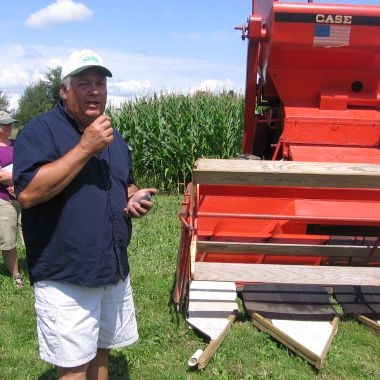
(Host) Everyone knows these are hard times on the farm.
But even as they face record low milk prices, farmers are looking for different crops to grow and new ways to improve the soil while protecting the environment.
Some of these innovations were on display in Alburgh this week, as researchers and farmers got together to check out results from recent field trials.
VPR’s John Dillon reports
(Tractor)
(Dillon) A big John Deere diesel pulls two large hay wagons full of people to a test plot of barley. University of Vermont Agronomist Heather Darby grabs a microphone and tells the crowd that barley could be an important crop for local brewers and distillers.
(Darby) "And we’re trying to fine tune some of the practices so that we can get better barley quality for malting in this state. So this is just getting started."
(Dillon) The next stop takes us from beer to breakfast cereal. A stand of oats is about waist high, the seeds look ready to be hulled.
Darby says there’s interest in local oatmeal. She says the next step for the researchers is to buy a hulling machine to process the oats for food.
(Darby) "So we’re evaluating many different oat varieties looking at how well they hull out, and also yields and quality of oats here in Vermont."
(Dillon) This is the fifth year that the UVM extension service and its team of soil scientists have shared their results with the public. The living laboratory is on Roger Rainville’s Borderview Farm – the name is no exaggeration, a cornfield on the other side of the road is in Canada.
Rainville milked cows for more than 40 years. He still raises heifers, but now he also grows canola and sunflowers and processes their oil into bio-diesel. He also clearly relishes helping other farmers learn.
(Rainville) "This is all stuff that applies to every farmer that’s trying to do these things. And me, myself being a farmer all these years, it’s like I’ve seen what it is when you go in to do these things and there are no studies done that pertain to this area. So this is really exciting for me because it’s questions that I wish were answered when I was trying to do these things."
(Dillon) Rainville is also chairman of the Farmer’s Watershed Alliance. The group helps farmers cut the phosphorus pollution that can flow off their land and into Lake Champlain.
That’s work that interests Julie Moore, who runs the state’s Clean and Clear program, which focuses on Lake Champlain water pollution.
A big problem in the lake is too much phosphorus that runs off farm fields. So Moore is closely following research that aims to limit the phosphorus-rich cattle feed that’s brought in from off the farm.
(Moore) "A lot of the grains that we feed cows are imported from the Midwest, so we’re bringing more phosphorus into the watershed. If we could grow some of that here, it could help reduce the bank of phosphorus that’s basically available to get into the lake."
(Dillon) Alburgh famer Morris Fortin was listening quietly to all the presentations. He was studying the tall rows of golden sunflowers. He says the seeds could be processed into feed for his cows and help cut his costs.
(Fortin) "Well, just something new to try to maybe try someday to offset the milk prices maybe."
(Dillon) And that was the goal of the day in the field – to provide advice that could be useful and keep the land in farming.
For VPR News, I’m John Dillon in Alburgh.